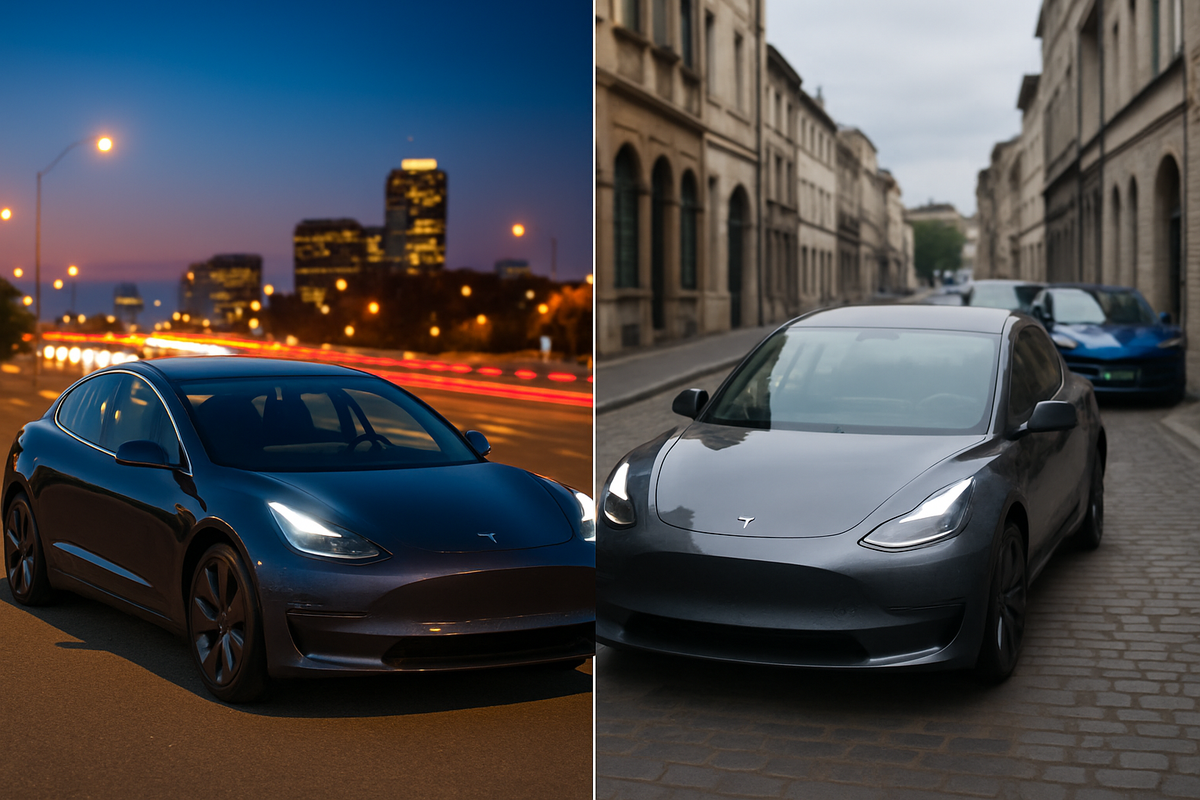
Tesla (NASDAQ: TSLA) has once again captured headlines with its robust third-quarter 2025 delivery performance, reporting record global vehicle deliveries that comfortably surpassed analyst estimates. This surge was primarily driven by an aggressive pull-forward of demand in the United States, as consumers rushed to capitalize on the expiring federal EV tax credit. While the strong numbers initially sent Tesla's shares soaring, a closer look reveals a more nuanced picture, with persistent weakness in the crucial European market posing a significant challenge for the EV giant.
The record deliveries, while a testament to Tesla's operational efficiency and brand appeal in certain regions, have ignited a debate among market analysts regarding the sustainability of this growth. The immediate implication is a potential slowdown in US sales for the upcoming fourth quarter, as the temporary boost from the tax credit deadline dissipates. This dichotomy between booming American demand and struggling European sales highlights the increasingly fragmented and competitive global electric vehicle landscape.
Detailed Coverage: A Quarter of Records and Regional Disparities
Tesla's Q3 2025 performance saw the company deliver an impressive 497,099 vehicles globally, marking a 7.4% year-over-year increase and significantly exceeding Wall Street's expectations, which had hovered around 448,000 units. This strong showing reversed two consecutive quarterly declines earlier in 2025. The mass-market Model 3 and Model Y were the primary drivers, accounting for 481,166 deliveries, while the Model S, Model X, and Cybertruck contributed the remaining 15,933. Production for the quarter stood at 447,450 vehicles, indicating that Tesla utilized existing inventory to meet the heightened demand. Beyond vehicles, Tesla's energy storage business also achieved a new record, deploying 12.5 GWh of energy storage products.
The timeline of events leading to this quarter's unique results is crucial. A significant catalyst was the impending expiration of the $7,500 federal EV tax credit in the United States on September 30, 2025. This policy change, enacted as part of a spending bill in July 2025, prompted a nationwide rush among consumers to purchase eligible electric vehicles. Tesla actively promoted this deadline, alongside other discounts and financing options, to accelerate sales. This strategic push, coupled with robust demand in China (where Tesla sold 162,900 EVs in Q3, a 31% increase quarter-over-quarter), largely underpinned the global record.
However, the narrative in Europe was strikingly different. Tesla experienced continued weakness in the European market, with vehicle registrations across the broader European region (including the UK, Norway, and EFTA countries) declining by approximately 22% year-over-year in August. Within the European Union, registrations fell by about 37% year-over-year in August, marking the second consecutive month where Chinese competitor BYD (OTC: BYDDY) outsold Tesla in the bloc. This downturn is attributed to intensifying competition from Chinese EV brands, aggressive promotion of plug-in hybrids by rivals, and some analysts pointing to consumer backlash over CEO Elon Musk's political activism.
Initial market reactions were mixed. On October 2, 2025, Tesla's stock (NASDAQ: TSLA) initially surged by 3.5% to 4% in early trading, cementing its position as a market leader and pushing its market capitalization beyond the $1.5 trillion threshold. However, caution quickly set in as analysts raised concerns about future demand, particularly for Q4, given the expiration of the federal tax credit in the US. This led to the stock falling nearly 1% later in the day, despite the delivery beat. Investors are now keenly awaiting Tesla's full financial results, scheduled for October 22, 2025, for further insights into profitability and future guidance.
Companies on the Rise and Facing Headwinds
Tesla's (NASDAQ: TSLA) Q3 performance presents a complex picture for the company and its rivals. While the record deliveries bolstered investor confidence and showcased its ability to generate significant sales volume, the reliance on a temporary US tax credit creates an overhang for Q4. The expiration of this credit means Tesla will likely face pressure to maintain demand in its largest market, potentially through further price adjustments or incentives, which could impact profitability and margins. The continued struggle in Europe, where Tesla is losing ground to both established European brands and aggressive Chinese entrants, also remains a significant concern, necessitating strategic adjustments to regain market share.
The expiring US federal EV tax credit created a similar "pull-forward" effect for other American automakers, boosting their Q3 EV sales but also casting a shadow over their Q4 performance. Ford (NYSE: F) reported booming EV sales in Q3, with a 30% year-over-year increase in deliveries (30,612 vehicles), driven by the Mach-E. However, Ford's CEO, Jim Farley, has expressed concerns about the post-incentive market, anticipating a dip in EV market share. General Motors (NYSE: GM) also experienced a record Q3 for EV sales, doubling deliveries to over 66,000 vehicles and becoming the second-largest EV seller in the US behind Tesla. Rivian (NASDAQ: RIVN) saw a nearly 32% increase in Q3 deliveries, totaling 13,201 vehicles, also benefiting from the tax credit rush, though it subsequently narrowed its 2025 delivery guidance. Lucid (NASDAQ: LCID) has reportedly been gaining traction by attracting some Tesla Model S and Model X customers, citing a perceived lack of significant updates to Tesla's premium models. These companies, like Tesla, now face the challenge of sustaining demand without the federal incentive.
In Europe, the competitive landscape is shifting dramatically. While Tesla (NASDAQ: TSLA) struggled with declining sales, Chinese manufacturers, particularly BYD (OTC: BYDDY), made significant inroads. BYD notably outsold Tesla in the EU in August 2025 with 9,130 vehicles, a 201% year-over-year increase, marking its second consecutive month surpassing Tesla in the region. Chinese brands are leveraging lower-priced models to gain market share, intensifying pressure on all incumbents. Traditional European automakers like Volkswagen (XTRA: VOW), Mercedes-Benz (XTRA: MBG), and BMW (XTRA: BMW) continue to expand their EV offerings, with the overall European EV market still growing, indicating that they are capturing market share that Tesla is losing. The competitive intensity in Europe forces these players to innovate and optimize production to remain viable.
Wider Significance: Policy Shifts and Global Competition
Tesla's Q3 2025 delivery performance, while a company record, is a stark illustration of broader industry trends and the profound impact of government policy. The expiration of the $7,500 federal EV tax credit in the US underscores the powerful role incentives play in shaping consumer behavior and market demand. This event created a significant "pull-forward" effect, temporarily boosting sales for Tesla and other EV manufacturers, but also signals a potential slowdown in the immediate post-incentive period. Policymakers globally will likely scrutinize this outcome as they consider future EV adoption strategies, weighing the benefits of short-term boosts against the risk of subsequent market corrections.
The ripple effects extend across the entire automotive ecosystem. For competitors, Tesla's strong Q3 raises the bar, forcing them to accelerate their own EV production, innovation, and delivery capabilities. While the tax credit's expiration may temper US EV sales across the board in Q4, it also creates a more level playing field where manufacturers must rely on product appeal, pricing, and brand loyalty rather than subsidies. This could lead to increased price competition and a greater emphasis on cost-efficient production. Suppliers to the EV industry, particularly those involved in battery technology and charging infrastructure, will likely see continued demand, albeit with regional variations mirroring the EV market's uneven growth.
Regulatory and policy implications are particularly salient. Beyond the US tax credit, European tariffs on China-made battery electric vehicles (BEVs), implemented from July 1, 2024, are directly impacting Tesla (NASDAQ: TSLA) and other manufacturers producing in China. These tariffs, ranging from 7.8% for Tesla to higher rates for some Chinese brands, aim to protect the European automotive industry. Since Tesla produces many Model 3 vehicles at its Shanghai Gigafactory, these tariffs are expected to lead to price increases for the Model 3 in Europe, further complicating Tesla's competitive position in an already challenging market. Conversely, US tariffs on Chinese EVs, championed by President Trump, are seen by some as a net positive for Tesla, making its US-manufactured vehicles comparatively more attractive domestically.
Historically, the automotive industry has seen similar market shifts driven by government incentives or economic changes. Programs like the "Cash for Clunkers" in 2009, which temporarily boosted sales, demonstrated a similar pull-forward effect followed by a subsequent dip, akin to what is anticipated after the EV tax credit expiration. Trade tariffs have also historically reshaped automotive markets, altering pricing and supply chains, as seen with the ongoing US-China trade tensions and the new EU tariffs. Tesla's current dominance in the EV sector, while unique in its technological foundation, can be compared to historical moments when a single manufacturer's innovations, such as Ford's Model T, profoundly reshaped the industry through mass production and accessibility. The wider significance lies in how these policy and competitive dynamics will continue to shape the pace and direction of the global transition to electric vehicles.
What Comes Next: Navigating a Shifting Landscape
The coming quarters will be pivotal for Tesla (NASDAQ: TSLA) and the broader electric vehicle market. In the short term (late 2025-2026), Tesla faces the immediate challenge of sustaining demand in the US post-tax credit expiration. This will likely necessitate strategic pivots, including potential price adjustments, enhanced financing options, and aggressive promotion of its technological advantages. Globally, Tesla is expected to continue focusing on cost reduction and the introduction of more affordable models, a crucial step to compete with increasingly budget-friendly Chinese EVs and expand its addressable market. The company's diversification into AI and energy, with robotaxi services and Optimus humanoid robot deployments, represents new, high-potential revenue streams that could offset volatility in vehicle sales.
For the wider EV market, global growth is anticipated to continue, though at varied regional paces. China will remain a dominant force, while Europe's growth will be driven by stricter emission standards. The US market, however, faces uncertainty due to policy changes. Intensifying competition is a certainty, with traditional automakers and Chinese brands like BYD (OTC: BYDDY) aggressively expanding their EV portfolios. Falling battery prices, driven by lower raw material costs, are making EVs more affordable, pushing the industry towards mass-market adoption. Continued expansion of charging infrastructure will also be critical to alleviate consumer range anxiety.
In the long term (2027 and beyond), Tesla's success hinges on maintaining technological leadership, particularly in autonomous driving (FSD v12 and beyond), which could unlock significant recurring revenue through subscription-based mobility services. Global expansion, especially into developing markets, and localized production will be key. The energy business and AI/robotics are poised to become core pillars of Tesla's long-term strategy, potentially transforming it into a diversified clean energy and AI powerhouse. However, managing complex supply chains and navigating geopolitical risks will be ongoing challenges.
Potential strategic pivots for competitors include diversifying EV offerings across various price points, investing heavily in battery technology and charging networks, and adapting to regional preferences. Aggressive pricing strategies will be essential, particularly against Chinese manufacturers. Emerging market opportunities, especially in developing economies and for two- and three-wheeler electrification, offer significant growth potential, but challenges such as high initial costs, lack of infrastructure, and consumer awareness must be addressed. Possible scenarios range from continued, albeit evolving, Tesla dominance to a more fragmented market with intense price wars, or even a slowdown due to macroeconomic factors and infrastructure lags. The resurgence of plug-in hybrids as a bridge technology is also a plausible outcome in some regions.
Comprehensive Wrap-up: Navigating the New Normal
Tesla's (NASDAQ: TSLA) Q3 2025 delivery performance served as a powerful rebound, showcasing the company's ability to drive significant sales volume and effectively clear inventory. The record numbers, largely fueled by the expiring US federal EV tax credit, underscore the potent influence of government incentives on market dynamics. However, this success is tempered by persistent weakness in the European market and the looming uncertainty of US demand in a post-tax credit era.
Moving forward, the EV market is entering a new normal characterized by fierce competition, evolving policy landscapes, and a growing emphasis on affordability. Tesla's ability to sustain its growth will depend heavily on its strategic response to these challenges, particularly its efforts to introduce more affordable models, expand its energy and AI divisions, and navigate the complex geopolitical and competitive pressures in key global markets. The company's innovative spirit and vertical integration remain significant advantages, but market share erosion, especially in Europe, signals the need for adaptability.
The lasting impact of this period will likely be a more mature and diverse EV industry. The temporary boost from the US tax credit highlights the transition from an incentive-driven market to one where fundamental product value, competitive pricing, and robust infrastructure are paramount. Tesla's continued investment in FSD and AI is critical, as these technologies could unlock new revenue streams and redefine mobility.
Investors should closely watch several key indicators in the coming months. Tesla's Q4 2025 delivery guidance, expected during the October 22 earnings call, will provide crucial insights into management's outlook for the post-tax credit environment. Changes in pricing strategy, the impact on automotive gross margins, and updates on the development and launch of a rumored "affordable model" will be critical. Furthermore, the performance of the Cybertruck and other premium models, alongside the continued expansion of the energy business and progress in FSD and robotaxi initiatives, will be vital for assessing Tesla's long-term growth trajectory. The broader economic climate, interest rates, and the intensifying competition from both legacy automakers and aggressive Chinese players like BYD (OTC: BYDDY) will also continue to shape the investment landscape for Tesla and the entire EV sector.
This content is intended for informational purposes only and is not financial advice.






